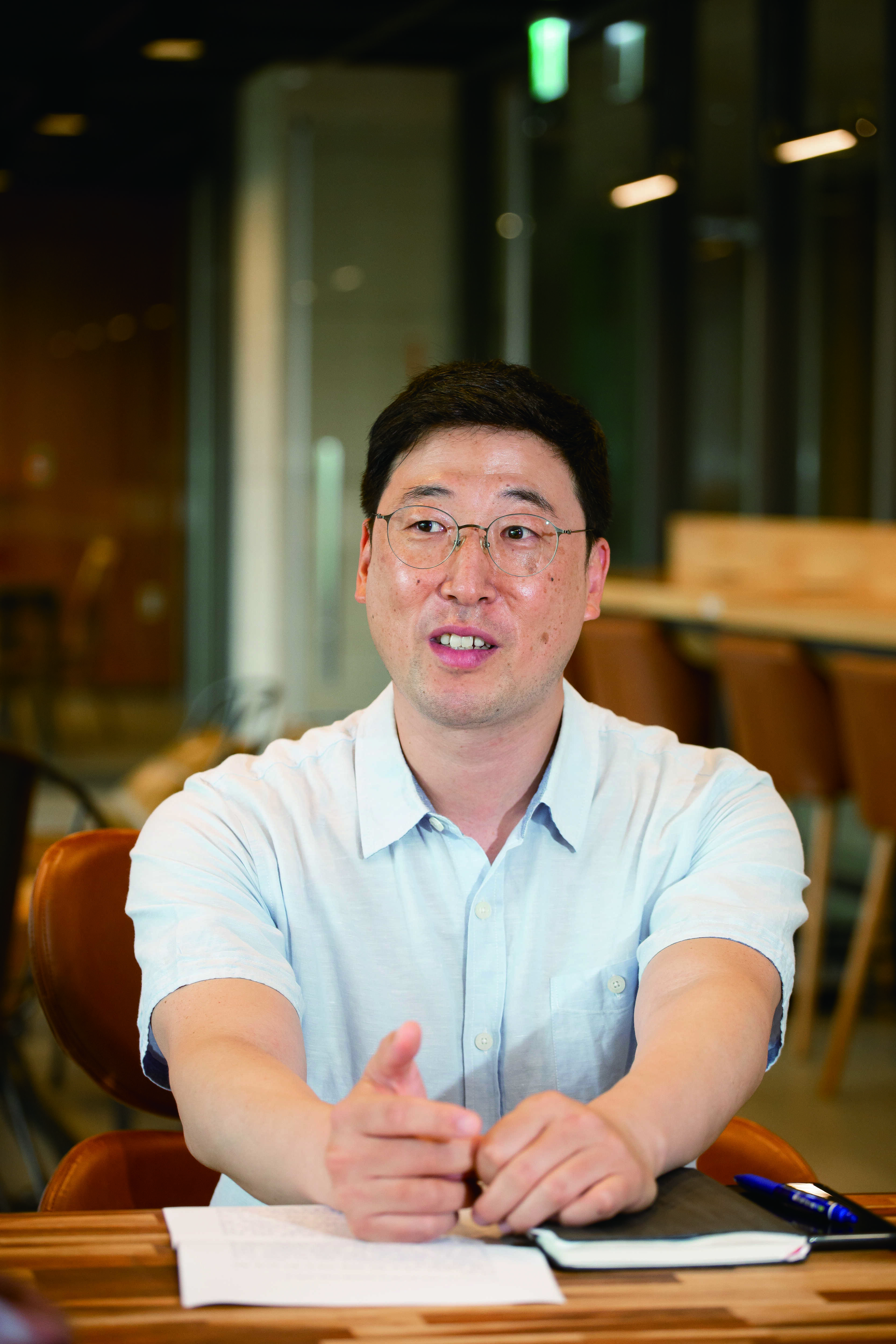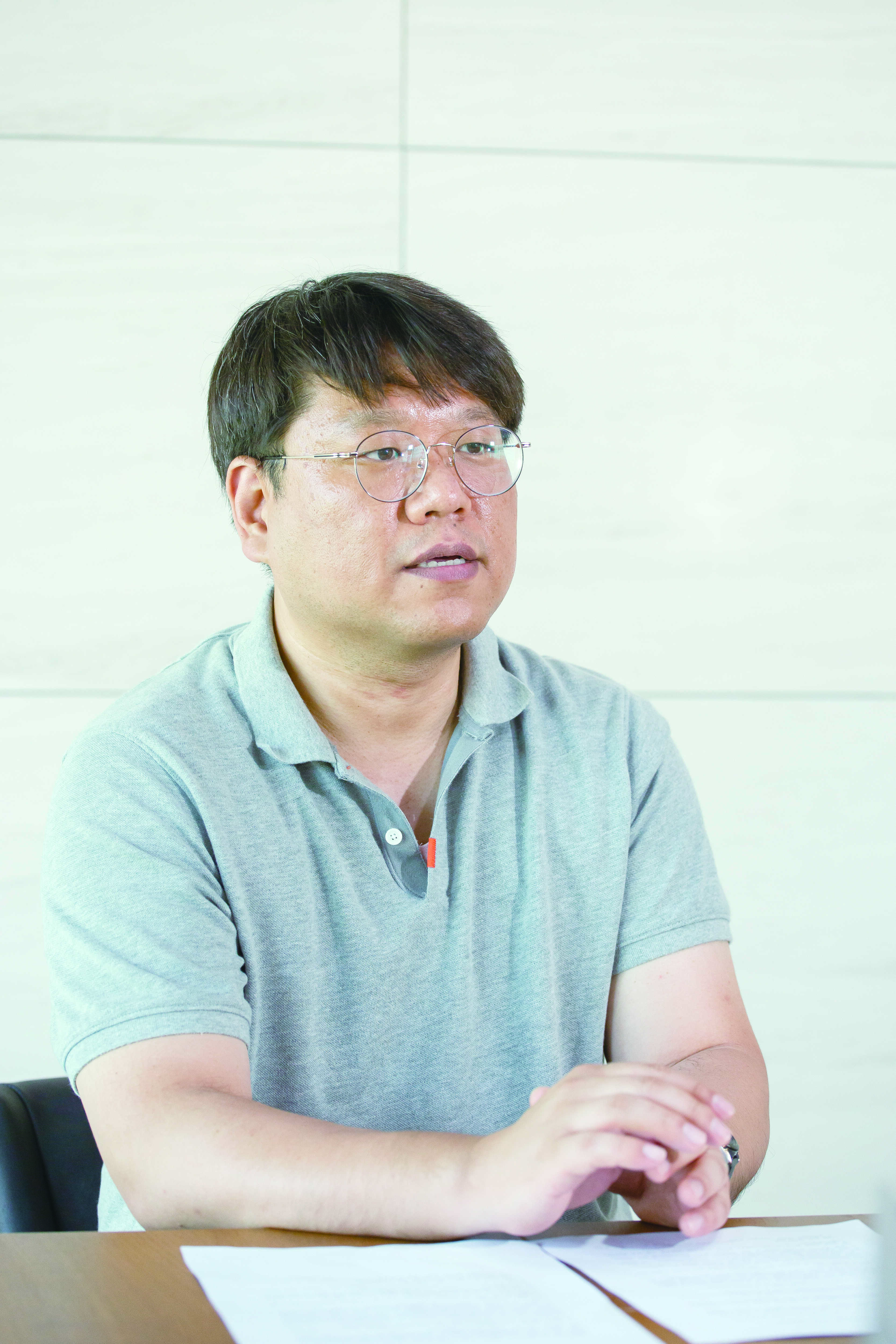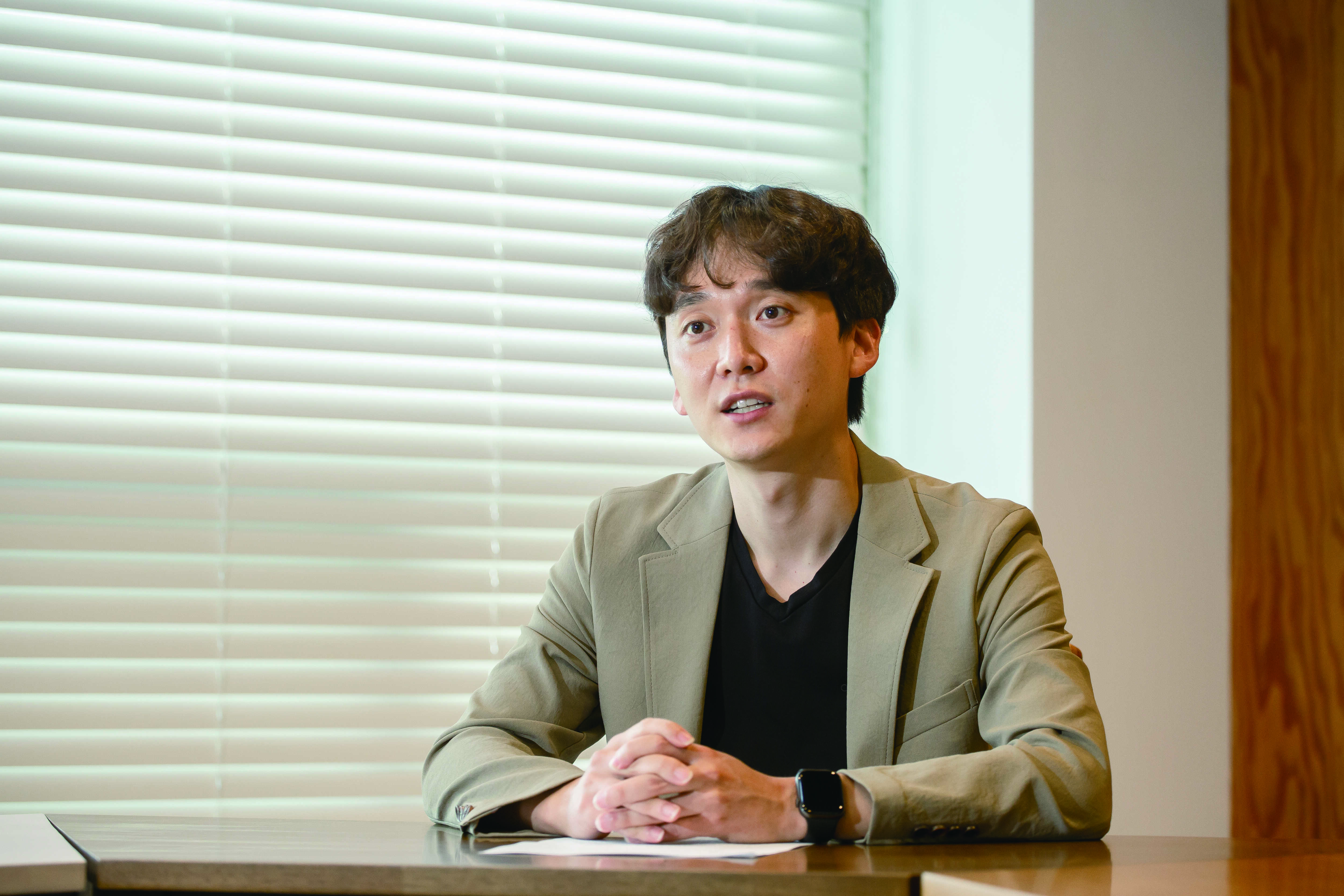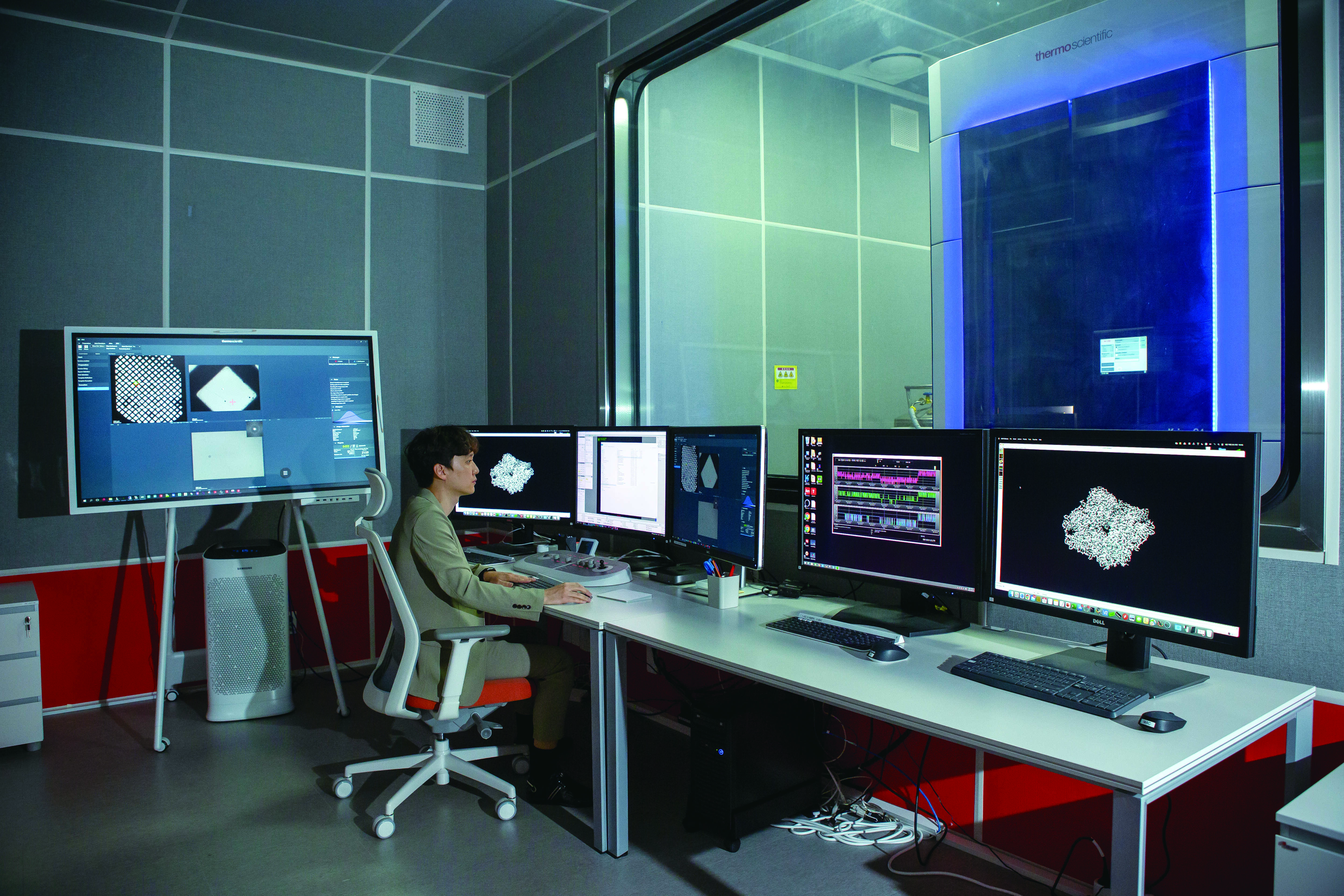주메뉴
- About IBS 연구원소개
-
Research Centers
연구단소개
- Research Outcomes
- Mathematics
- Physics
- Center for Underground Physics
- Center for Theoretical Physics of the Universe (Particle Theory and Cosmology Group)
- Center for Theoretical Physics of the Universe (Cosmology, Gravity and Astroparticle Physics Group)
- Dark Matter Axion Group
- Center for Artificial Low Dimensional Electronic Systems
- Center for Theoretical Physics of Complex Systems
- Center for Quantum Nanoscience
- Center for Exotic Nuclear Studies
- Center for Van der Waals Quantum Solids
- Center for Relativistic Laser Science
- Chemistry
- Life Sciences
- Earth Science
- Interdisciplinary
- Center for Neuroscience Imaging Research (Neuro Technology Group)
- Center for Neuroscience Imaging Research (Cognitive and Computational Neuroscience Group)
- Center for Algorithmic and Robotized Synthesis
- Center for Genome Engineering
- Center for Nanomedicine
- Center for Biomolecular and Cellular Structure
- Center for 2D Quantum Heterostructures
- Center for Quantum Conversion Research
- Institutes
- Korea Virus Research Institute
- News Center 뉴스 센터
- Career 인재초빙
- Living in Korea IBS School-UST
- IBS School 윤리경영


주메뉴
- About IBS
-
Research Centers
- Research Outcomes
- Mathematics
- Physics
- Center for Underground Physics
- Center for Theoretical Physics of the Universe (Particle Theory and Cosmology Group)
- Center for Theoretical Physics of the Universe (Cosmology, Gravity and Astroparticle Physics Group)
- Dark Matter Axion Group
- Center for Artificial Low Dimensional Electronic Systems
- Center for Theoretical Physics of Complex Systems
- Center for Quantum Nanoscience
- Center for Exotic Nuclear Studies
- Center for Van der Waals Quantum Solids
- Center for Relativistic Laser Science
- Chemistry
- Life Sciences
- Earth Science
- Interdisciplinary
- Center for Neuroscience Imaging Research (Neuro Technology Group)
- Center for Neuroscience Imaging Research (Cognitive and Computational Neuroscience Group)
- Center for Algorithmic and Robotized Synthesis
- Center for Genome Engineering
- Center for Nanomedicine
- Center for Biomolecular and Cellular Structure
- Center for 2D Quantum Heterostructures
- Center for Quantum Conversion Research
- Institutes
- Korea Virus Research Institute
- News Center
- Career
- Living in Korea
- IBS School
News Center
| Title | Racing forward together to deliver remarkable achievements | ||||
|---|---|---|---|---|---|
| Name | 전체관리자 | Registration Date | 2022-01-11 | Hits | 1199 |
| att. |
 thumb.jpg
thumb.jpg
|
||||
Racing forward together to deliver remarkable achievementsA 3-Story Interview with 3 Experts from the Research Solution CenterYou can’t do much with just the main character alone. A story comes to life when there are supporting roles to bring light on the lead. While not noticeable at first sight, you can never talk about a movie without them. This is the reason why various movie festivals celebrate and recognize supporting roles by announcing the ‘best supporting role awards’ in addition to the ‘best actor awards’ for the lead roles and ‘best director awards’ for directors in charge of the overall production. This goes the same for the research in modern science. Most projects are of massive scale that cannot be managed by a single researcher. Under the goal of providing the best possible support to researchers, IBS has launched the Research Solution Center to better manage high-priced research facilities and enhance research efficiency.
The Research Solution Center was launched in May 2020. The Center was created by integrating the research facility teams of IBS, which operated independently from one another prior to the integration, to better support overall research efficiency. It currently operates three sections in the fields of laboratory animals, data, and imaging. Each of the sections collaborates with various research centers to support their research initiatives. We met with the representative technical experts of each section to listen to their stories. “Working together end-to-end for ethical and successful research” Senior Technician KIM Hwan
The Laboratory Animal Resource Facility supports the Research centers for Life Sciences in IBS, and it started its comprehensive support operations in September 2019. The facility can accomodate a maximum capacity of 6,000 cages (30,000 heads) of mice (Mus musculus). The Laboratory Animal Resource Facility not only cares and manages laboratory animals but also supports the seamless operations of animal experiment. At times Regularly, it also provides education and training programs on laboratory animal experiment and welfare to researchers. Senior Technician KIM Hwan, the manager of the Laboratory Animal Resource Facility, oversees the overall operations related to animal protocol. In general, the word “vet” would remind most people of a clinical veterinarian at an animal hospital, diagnosing and treating pets. “I actually worked as a clinical veterinarian for about 7 years. While working at my former job, I came across laboratory animals, which is how I became attracted to the various fields of research. Now, I am working as a laboratory animal vet.” Senior Technician Kim told us that it was interesting to provide advice on the health and welfare of laboratory animals. The diverse fields of research relating to lab animals are another point of interest. Ever since becoming a lab animal vet, he not only looks after the health of the animals but also follows them wherever they go from the start of the research to its completion. “It does not just end after provision of the lab animals for research. We have to check on the post-experiment status of the animals and whether the experiments were completed in a humane manner.” No matter what rhetoric is used to describe it, ultimately, animal experiment is the process of using and sacrificing other lives for the advancement of mankind. Therefore, it is crucial to confirm whether animal experiment processes were carried out in an ethical manner. To this end, the managers at the Laboratory Animal Resource Facility support the researchers using various approaches. First, the most critical role is to provide healthy laboratory animals. Basically, SPF (Specific Pathogen Free) facilities are operated to prevent and manage pathogenic infection incidents that can affect experiments. IBS further divided the facilities in detail. With the three SPF zones at the center, the facilities were divided into the breeding zones with stricter infection controls and the Semi-SPF zone, which screens access by implementing relatively relaxed controls. Different access rules were applied to each zone to restrict access by the intended purpose of experiments, thereby minimizing the risks of infections. Second, the laboratory animals are checked and managed throughout an appropriate research process from the start to the interim and final stages of the research, in compliance with the guidelines on laboratory animals issued by the Institutional Animal Care and Use Committee (IACUC). “Animal protocol need to be prepared and submitted for review and approval by the IACUC to carry out animal experiments. Once the experiments start, it is also my duty to check on whether the experiments are progressed according to the approved animal protocol and whether the animals are excessively suffering in the process of the experiments. It is also important to recommend the timing for the humane endpoint of experiments.” The timing for humane endpoint of an experiment refers to the point in time when it is appropriate to quickly perform euthanasia to reduce the pain and distress caused, rather than continuing with the experiments until the death of the animals, other than in special circumstances. This is recommended when the health state of the animals deteriorates, such as when they lose their appetite, activity, or show sudden decreases in body weight. Lastly, when not involved in an experiment, the animals need to be provided with an adequate environment to ensure their comfort. For example, a maximum of 5 mice are to be housed in a single cage. The temperature, humidity, and lighting as well as noise and odor levels are strictly managed within normal range. At times, the stress levels are also reduced by introducing environmental enrichment programs, such as through providing cotton, nesting sheet, wooden toys. The Laboratory Animal Resource Facility also spares no effort in collaborating with other research centers to ensure successful research achievements. Currently, the center that is most actively engaged in animal protocol is the Center for Cognition and Sociality. As the centers share close working relationships, regular steering committee meetings are held to understand the needs of the centers. There are also plans to diversify the laboratory animal species in line with the requirements of the researchers. The facility, while only managing mice currently, plans to introduce rats (Rattus novegicus) within this year. Unlike the mice, which weigh a mere 20~25g, the rat (300g) is widely used in basic research, experiments that require surgical operations, or in diabetic models. Would it be possible to produce laboratory animals within the facility on top of the ongoing procurement and management of animals generally requested by the researchers? The full-time veterinarian Kim answered that they will be able to further develop the currently ongoing supply of mice by leveraging established IBS know-how. “IBS is a research institution established for the development of basic sciences. It might be able to supply mice specialized for the fields of neuroscience, gene editing, or protein communication to other institutions.” “Supporting research with just the right customized computing system” Chief Technician HEO Mu Young
‘Whirrrrrrrrrr-’ The noise coming from the computer room housing the supercomputer ‘Aleph’ was very loud. Chief Technician HEO explained that it was the sound of the cooling fans running to dissipate the heat produced by Aleph. “In a typical computer room, you would see as many as 40 nodes for each rack. However, there are 192 nodes for Aleph. As it features a high degree of integration, it is vital to control the amount of heat that is produced. We use a liquid cooling system instead of generic coolers.” The liquid-type cooling system functions initially with the coolant absorbing the heat, and then with the heated liquid being cooled by radiators. This type is generally known to generate little noise, but it was still difficult to continue with our conversation. Based on the sound alone, you could only guess what kind of complex operations the supercomputer was working on. The Data Section of the Research Solution Center recommends and provides various computational resources, including Aleph, that are required for performing research. Chief Technician Heo first joined the Center for Climate Physics back in 2017 and started working on the management of Aleph since its introduction. “I originally majored in computational Statistical Physics using Simulations. When I came to work at the Center for Climate Physics, there were not enough computers to carry out research. While building the computing resources by myself, I came to realize my new, unexpected potential.” When we refer to computing resources, it does not simply refer to hardware like Aleph. All elements required when working on a computer, including research software and computing time, are expressed as ‘resources.’ In modern scientific research, computing resources are core research facilities that we cannot do without. In particular, the researchers crave access to supercomputers, which can perform enormous numbers of calculations in an instant. “Researchers in material science want to calculate the electron shell structures by utilizing approaches based on quantum physics. The field of molecular biology requires simulation of various protein structures in the virtual setting. Computers can also calculate how synthetic organic matter will react. In other parts of the world, supercomputers are also used for the modeling of galaxies based on theories of cosmology.” IBS’s Aleph is mainly used for research on climate science. With its superhigh-resolution simulations, climate prediction models are created to forecast the climates of the past, present, and future. Others, including the Center for Relativistic Laser Science, the Center for Theoretical Physics of Complex Systems, the Center for Integrated Nanostructure Physics, and the Center for Multidimensional Carbon Materials, also frequently use Aleph in carrying out their research. The Data Section features more than just Aleph. They also have ‘Olaf’, which was introduced in 2020. Olaf is the big data analysis hub, which can simultaneously perform numerous simple calculations in an instant. It plays a vital role in the analysis of image data, which will be described in the next chapter.
“The required facilities may change depending on what kind of calculations are to be performed in the research. Complicated calculations, such as those performed in the climate models, require supercomputers with densely integrated CPUs. On the other hand, GPUs are needed to perform quick simple calculations in large quantities. Sometimes, memory is critical when you wish to perform analysis of big data.” IBS also makes decisive investments to build computing resources that are fit for different circumstances. Olaf required an investment of about KRW 1.2 billion, while the storage for storing research data cost about KRW 1.3 billion. The stored research data will be gradually collated with curations and is expected to be provided to researchers for joint utilization. They also have a bigger plan, with a second supercomputer to follow Aleph. “The typical lifespan of a computer is presumed to be around 5 years. This is because you can buy a new system with identical performance for the same price as the maintenance costs of the original installation after 5 years. In 2023, it will be 5 years since Aleph started operations. At that point, we plan to install a second supercomputer with about 10 times the performance of Aleph.” Chief Technician Heo tipped us off on how he wanted to introduce a new supercomputer beginning in the third year since the introduction of Aleph. The reason was that it was quite complicated to port the research software and data every time a new system comes in. The 3-year cycle introduction is a method typically used in the US, where they run both the old and new systems simultaneously for a 2- to 3-year period and slowly migrate the internal data in a systematic manner. Despite all of these variables, Chief Technician Heo works closely with researchers with all the available resources to best support their work. “South Korea already has numerous talented researchers. It is my goal to at least ensure that these researchers are not prevented from being able to conduct their desired research due to the lack of facilities (computer resources).”
“Creating a competitive edge with cryo-EM, keeping up with ever-changing technological trends” Senior Technician RYU Bum HanThe research methodology paradigm has dramatically changed in the last few years in the field of structural biology. While protein crystal structures were analyzed by X-ray diffraction using the radiation accelerator previously, the contemporary approach identifies the protein structures by using the images obtained from cryogenic electron microscopy (“cryo-EM”). Cryo-EM research methodology also played the main role in winning the 2017 Nobel Prize in Chemistry. Aqueous solutions containing dissolved proteins are frozen by cooling them to cryogenic temperatures, and electron microscopes are used to observe the structures of the proteins in their physiological states. Senior Technician RYU Bum Han serves as the support expert who takes the images of protein samples using the cryo-TEM located at the IBS and reconstructs their 3-D structures. “Cryo-EM is advancing at an exceptional speed. As we are applying the latest technologies developed overseas to the facilities at IBS, there are already other new technologies being developed at the same time.” Senior Technician Ryu shook his head as he spoke about the speed of development in the field. IBS brought in the 200kV and 300kV cryo-TEM facilities back in March and September of 2020, respectively. In particular, the detector of the 300kV cryo-TEM features CDS (correlative double sampling) technology. This is the technology that creates images with improved signal-tonoise ratios by quickly comparing the images in succession and filtering out the unnecessary data from the essential data. This was a technology with shortcomings for practical applications at the time of the facility’s installation, which has now become operational in just a few months’ time. The real-time pre-processing system has also become common during the installation of cryo-TEM equipment. For that reason, Senior Technician Ryu had to remain fully engaged day and night to apply and verify the new technologies. “It is really enjoyable to apply new equipment or technology and deliver results faster than anyone. I feel like I am doing my job because I’m interested in all of this personally, but it can also really help other people (researchers) as a result.” When asked if he was having fun at work, Senior Technician Ryu replied with a quick smile, mentioning that it was an advantage to have a job that didn’t depend on research outcomes, unlike other researchers. Senior Technician Ryu did not start with cryo-EM at first. Back in 2015, during his doctoral studies, he was selected for an overseas training program hosted by NRF-DAAD. Receiving training at the Department of Biochemistry at the German Max Planck Institute gave him the opportunity. Considering that three Nobel Prizes in Chemistry were awarded in 2017 for the researchers’ contributions in the development of the cryo-EM research methodology, Ryu was introduced to the field of cryo-EM rather quickly.
Let us briefly have a look at the process of obtaining a 3-dimensional protein structure with a cryo-EM. First, the researchers bring in prepared samples of proteins or cells. This is where the job begins for Senior Technician Ryu. These samples are frozen using plunge freezer, and this process is so called vitrification. The specimen is vitrified to prevent the undesired formation of ice crystals from the protein solutions. Then, images are taken with the transmission electron microscope. While it may sound very simple and easy, proteins are very vulnerable to electron beam damage. Strong electron beams cannot be used to obtain high-resolution images as in general material sciences. The key here is to optimize the level of exposure to electron beam the electron beam so as to avoid serious protein denaturation during imaging. Thousands to tens of thousands of images are taken to overcome the noise generated due to the weak energy level of the beams. These images are then processed with computer programs and reconstructed from 2-dimensional images rich with noise to high-resolution 3-dimensional structure models. Olaf, introduced in the previous chapter, performs this very function. References were made to various international facilities to set up world-class research facilities. NECEN, recognized as the national electronic microscopy center of the Netherlands, and OIST, the research institution located in Okinawa of Japan, were used as benchmarks. The EM Center of the Diamond Radiation Accelerator Facility in England (eBIC: Electron Bio-Imaging Centre) was also referenced for optimizing the energy filter of direct electron detector (the BioQuantum K3 Imaging Filter), which has a low supply rate due to its high price. The Diamond Light Source is a synchrotron constructed in 2007 and the largest basic sciences facility in England. Supported by such passion, Ryu has completed imaging processes for more than 60 samples since the launch of the pilot services in November 2020. In the second half of 2021, the facility will officially start to provide the services based on the know-how accumulated during the pilot service period. Senior Technician Ryu commented, “There have been many cases where our talented researchers lost out to international researchers, due to the lack of human resources and physical infrastructure,” and added that “I hope there will be sufficient support to prevent such unfortunate incidents in the future.” |
|||||
| Next | |
|---|---|
| before |
- Content Manager
- Public Relations Team : Yim Ji Yeob 042-878-8173
- Last Update 2023-11-28 14:20










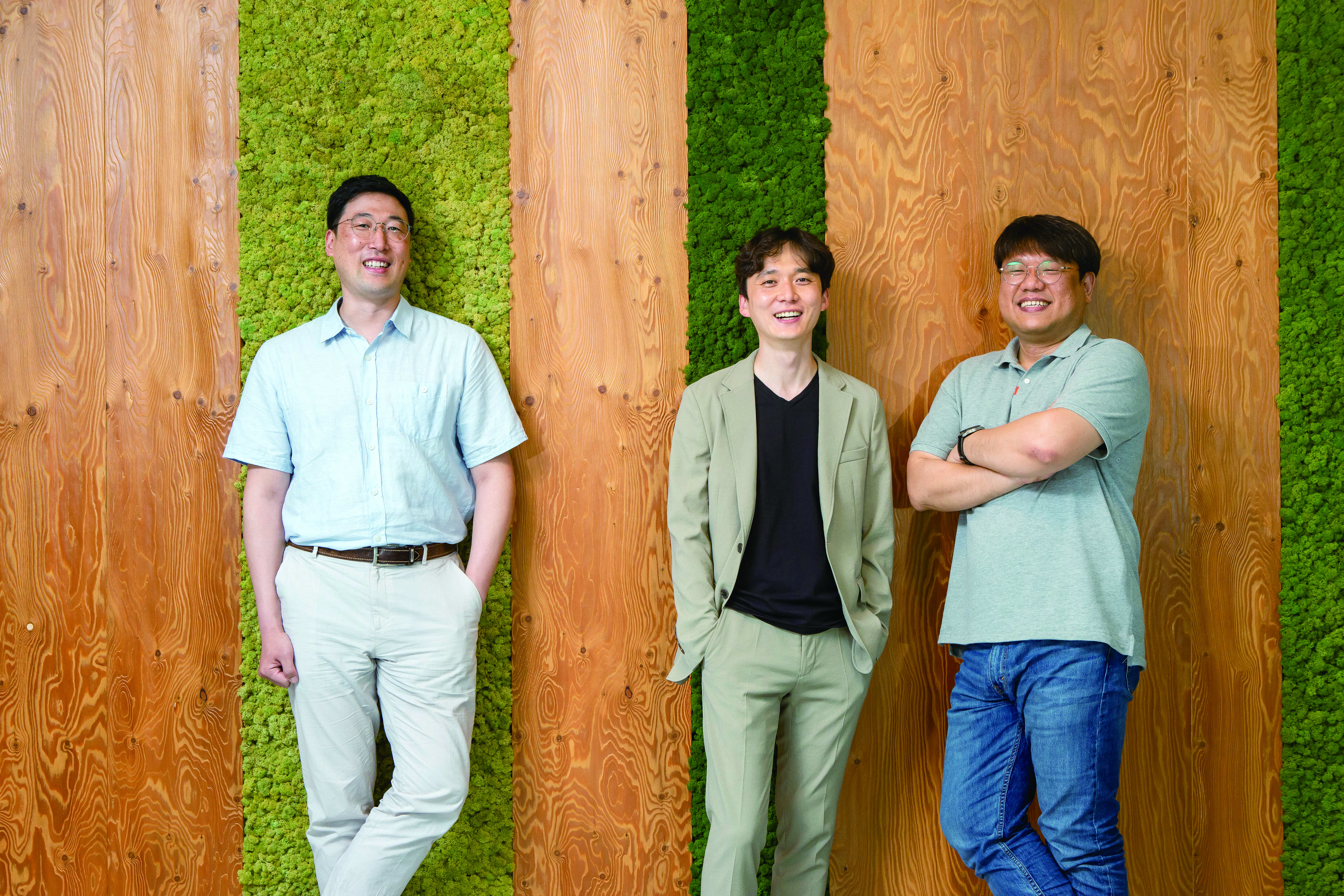 Senior Technician KIM Hwan, Senior Technician RYU Bum Han and Chief Technician HEO Mu Young from left.
Senior Technician KIM Hwan, Senior Technician RYU Bum Han and Chief Technician HEO Mu Young from left.